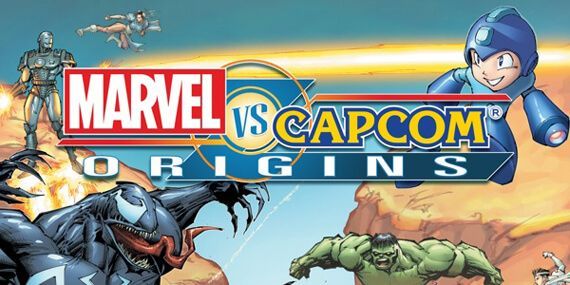
Marvel Vs Capcom: Origins
By Aaron Leach 06 December 2012

Gamers old enough to remember the days of putting their quarter up on the ledge of an arcade cabinet’s screen so that they “got next” no doubt have some level of familiarity with both Marvel Super Heroes and Marvel vs. Capcom: Clash of Super Heroes.
Should those players, as well as any newcomers, require a trip down fighting-game memory lane, Capcom is happy to oblige with the recent release of Marvel vs. Capcom: Origins, featuring both of the aforementioned titles. Does this downloadable duo make the old feel new again, or is Capcom simply looking to cash in on gamer nostalgia, as well as the current pop culture frenzy surrounding all things Marvel-related?
Marvel vs. Capcom: Origins (MVC:O) manages to pack two complete arcade games into one digital package, and even though there might be some character and move overlap, each title offers a different take on the fighting genre that will keep players on their toes as they jump back and forth between the two. The arcade-perfect recreation of both games is indeed a mostly successful endeavor, but that’s not to say the game isn’t without a few quirks here and there.
Marvel Super Heroes, which originally debuted in 1995, is the more basic of the two titles on hand. Its one-on-one combat still plays like Street Fighter but with a ten-man roster of Marvel characters. The hook here is the inclusion of Infinity Gems. These will act as power-ups that the player has at their disposable and knowing when to use them, and which ones best benefit which character, can help swing the outcome of a match. Fans of the recent Avengers movie will also get a taste of Thanos to tide them over until he shows up in another flick.

Marvel vs Capcom: Clash of Super Heroes first hit arcades in 1998, and almost fifteen years later, it still holds up really well. This is due to the fact that this game features many of the foundational mechanics that are still present in modern fighters. Team-based matches, advancing guard and a handful of other fighting game staples can all be seen here, and players mostly familiar with only newer entries into the Marvel vs. Capcom franchise shouldn’t have too much trouble jumping into the thick of things.
Overall, both games are a joy to pick up again and shine as an example of the timelessness of solid gameplay mechanics. Sure there are still some odd difficulty spikes that were designed to eat quarters rather than promote balance, and the speed and responsiveness of today’s fighters are definitely a step ahead, but these bumps in the road are easily overlooked once the player is knee-deep in digital fisticuffs, basking in the bliss of pure, untainted fighting mechanics. The two-game package also serves as a great history lesson of the genre. Even noting the differences between the two games offered shows what a leap fighters took in just a couple years.
If there’s anything that could be considered somewhat negative to be thrown in the direction of MVC:O, it’s that it will be hard pressed to attract many newcomers to the genre. The uninitiated will be keen to remember that these games were released at a time when arcade fighters were still fairly popular, and success was based on the mastery of the mechanics within, not given by accessibility to a mass audience. The button-mashed victories that can be “achieved” in Marvel vs. Capcom 3 and its off-shoots are not so easily obtained here. These are both fighting game fans’ fighting games, and the casual player will have their work cut out for them. Again, this really shouldn’t even be considered a bad thing, as purists will love the integrity preserved here, but for those that don’t want to put in a little effort, they might not be so happy with the experience.

The visual presentation of MVC:O is a bit of a mixed bag. There’s no shortage of options in this department due to the number of screen sizes and image filters that can be applied to the game. Players are offered a variety of viewing angles from an over-the-shoulder, standing at the arcade cabinet look to a stretched-out fill-the-entire-television-screen view and everything in between. Most likely that the majority of players will pick a perspective that falls somewhere in between those two extremes, it’s nice to have the options. However, when looking at the regular 4:3 presentations, the sidebars on the screen are filled with a drab gray. With a wealth of concept art, and just Marvel art in general, it’s a shame things weren’t spiced up a bit with some great artwork in the frames. This “least amount of effort possible” ho-hum design also spills over into the various menu screens. It’s just a very vanilla presentation.
The other bit of visual flair comes in the form of video filters. Players have the choice to smooth out the image and even add or remove the old scan lines from the picture. Much like choosing the game’s aspect ratio, this is something that most players will probably leave at the default settings, but it’s still a kitschy bit of nostalgic fun to play around with.
One new feature that may bring up mixed feelings in the cockles of fighting game fans is the inclusion of a challenge system. Completing certain tasks will net players points that can then be used to open up unlockables within the game. These feats include things like performing a certain number of Hyper Combos or in-match taunts, and the game does a good job of showing exactly how far away the player is from reaching the next challenge milestone by displaying the numerical progress in the outer frame of the screen. However, the conflicting emotions arise when one considers what some of those unlockable rewards are exactly.

For example, it certainly is fantastic to be whisked back to simpler times when hidden characters, or rather variations of existing ones, could in fact be obtained simply by playing the heck out of the game rather than forking over more money for DLC or a different version a few months later. The irony of having this feature in a Capcom fighting game is pretty hard to miss. On the other hand, items like the intro movies for each game also require unlocking with points if the player wishes to view them. This wouldn’t be worth noting if not for the fact those movies don’t even play on their own when loading the game up. Not having these quick clips play on their own just adds to the somewhat bland aesthetic presentation.
Another aspect to completing challenges is the game’s leveling system. Of course the word “system” is used here in the loosest possible sense of the word since the player’s level seems to have no impact on the game whatsoever. Those that feel the need to complete every part of the game may find a reason to keep on grinding, but most will just recognize it for the arbitrary number that it is. It’s obviously not the worst offense in the world, just an unnecessary one.
Online play is a given for fighting games in this day and age, and Capcom has of course included it here. Ranked and player matches are both present as well as an option for spectating. The ability to record and save your matches is also a great addition to MVC:O. Matches do utilize an adjustable GGPO scale which helps keep the experience pretty much lag free. Each game played excellently online in this regard, and if it weren’t for the throwback visuals, the online experience could easily be passed off as a newly released fighter.

The only online obstacle was actually getting into a match. Whether there are issues with the game’s matchmaking system or just not enough people playing, starting a match took anywhere from a few seconds or upwards of ten minutes – to simply getting tired of waiting and putting the controller down. There are toggle settings to look for players of the same skill level or geographical location, but when the game struggles to find a match at all, limiting its search scope isn’t something that will benefit anyone who just wants to quickly get into a game.
Despite some odd menu design choices and a few online hiccups, MVC:O does a tremendous job of preserving the fun and challenging experiences that made both of these games special. It shines a light on a turning point within the history of the fighting genre and manages to let players have a great time with characters they love in the process. If you’re old enough to remember what an arcade smells like, or the original Onslaught comic story arc, or if you’re a newer fighting enthusiast eager to learn some of your roots, then MVC:O will not disappoint.
Marvel vs. Capcom: Origins is currently available on both XBLA (1200 MSP) and PSN ($14.99). Game Rant played the Xbox 360 version for this review using a standard Xbox 360 controller.
